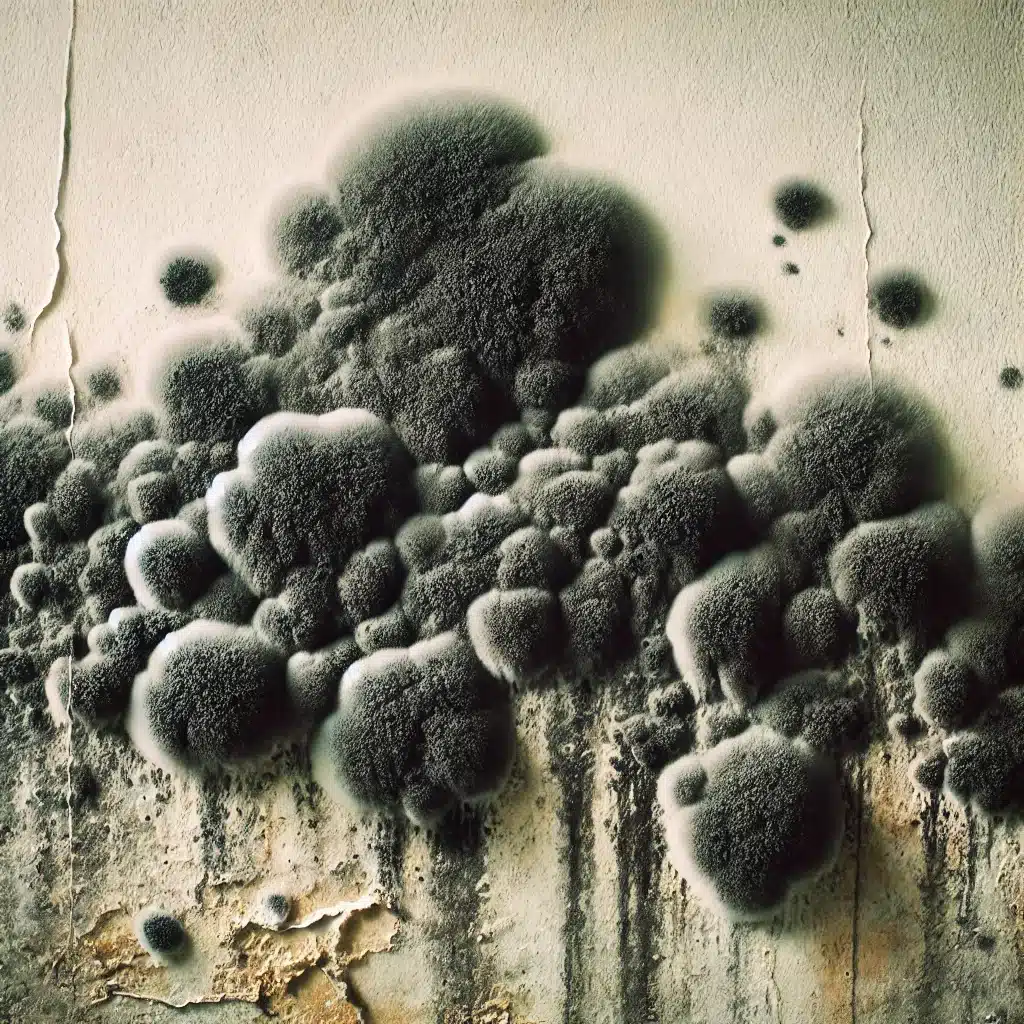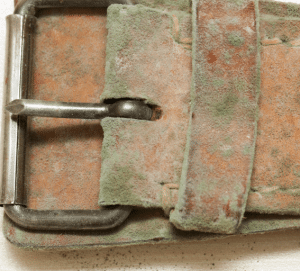Black mold, scientifically known as Stachybotrys chartarum, is more than just an unsightly presence in your home; it’s a type of toxic mold that can pose serious health risks and cause significant damage to your property. This pesky mold thrives in damp, humid environments, making it a common issue in places like bathrooms, basements, kitchens, and any area that has experienced water damage.
Identifying and dealing with black mold promptly is essential to maintaining a safe and healthy living environment. If left unchecked, black mold can lead to respiratory problems, allergic reactions, and even severe neurological issues, especially for those with pre-existing health conditions. Moreover, it can compromise the structural integrity of your home, leading to costly repairs and potential safety hazards.
In this guide, we’ll cover everything you need to know about black mold. We’ll explore its causes, the symptoms and complications it can bring, how to spot it, and the most effective ways to remove and prevent it. Armed with this knowledge, you can take proactive steps to protect your home and your health from the dangers of black mold. So, let’s dive in and learn how to keep your living space mold-free!
What Causes Black Mold?
Understanding what causes black mold is essential for preventing its growth in your home. Black mold thrives in environments where there is consistent moisture and poor ventilation. These conditions create the perfect breeding ground for mold spores to settle, grow, and spread. Recognizing the common causes of black mold can help you take proactive steps to mitigate these risks, ensuring a safer and healthier living environment.
Here are some common causes:
Leaks
Persistent leaks in roofs, walls, or plumbing can create the perfect environment for mold growth. Even minor leaks, if left unattended, can result in significant moisture buildup. Over time, this moisture seeps into building materials, providing the dampness that black mold needs to thrive. Regularly checking for and promptly repairing leaks can prevent these issues.
Flooding
Flooded areas that aren’t thoroughly dried can become mold hotspots. After a flood, it’s crucial to dry out all affected areas as quickly as possible. This includes not just the visible surfaces but also hidden areas like behind walls and under floors where moisture can linger and mold can easily develop. Using industrial dehumidifiers and fans can help speed up the drying process.
Condensation
High humidity levels and poor ventilation can lead to condensation on walls and windows, encouraging mold growth. Condensation typically forms when warm, moist air comes into contact with cooler surfaces. This is common in bathrooms, kitchens, and areas where ventilation is inadequate. Installing exhaust fans, using dehumidifiers, and ensuring good airflow can help reduce condensation.
Dampness
Consistently damp areas, such as basements and bathrooms, are particularly susceptible to mold growth. Basements often have higher humidity levels due to their below-ground nature, and bathrooms are constantly exposed to water from showers and sinks. Keeping these areas dry is essential to prevent mold. Regularly using a dehumidifier in the basement and ensuring good ventilation in bathrooms can significantly reduce the risk.
Is Black Mold Bad?
Black mold is considered harmful for several reasons. It offers serious health hazards and can cause substantial damage to your house. Here’s a closer look at why black mold is bad and why it should be addressed promptly.
Health Risks
Exposure to black mold can lead to various health issues that range from mild discomfort to severe health complications. Recognizing the symptoms associated with black mold exposure is crucial for early detection and intervention. Mold spores can affect different systems in the body, leading to a variety of symptoms that can significantly impact your quality of life. Understanding these symptoms can help you take action to address mold problems and protect your health.
Here’s a detailed look at the common symptoms caused by exposure to black mold:
Respiratory Problems
Black mold spores can irritate your respiratory system, causing symptoms such as coughing, wheezing, and shortness of breath. These issues can be particularly severe for individuals with asthma or other pre-existing respiratory conditions.
Allergic Reactions
Many people experience allergic reactions when exposed to black mold. Symptoms include sneezing, a runny nose, and itchy eyes or skin. These reactions can be mild to severe and often worsen with continued exposure.
Chronic Fatigue
Prolonged exposure to black mold can lead to feelings of tiredness and weakness. This chronic fatigue can impact daily life and reduce overall well-being.
Headaches
Frequent headaches or migraines can be a sign of mold exposure. These headaches are often persistent and can be debilitating, affecting your ability to concentrate and perform daily tasks.
Neurological Symptoms
In severe cases, exposure to black mold can cause neurological symptoms such as memory loss, mood swings, and confusion. These symptoms can significantly affect mental health and cognitive function.
Black Mold Complications
Black mold is more than just an unsightly nuisance; if left untreated, it can lead to severe and far-reaching complications that impact both your home and your health. The presence of black mold in your living space can result in significant structural damage, worsening health conditions, and toxic exposure, each posing serious risks. Understanding these potential complications underscores the importance of early detection and remediation. By being aware of the dangers associated with untreated black mold, you can take proactive steps to protect your property and well-being.
If left untreated, black mold can cause severe complications:
- Structural Damage: Mold can weaken the structural integrity of your home, leading to costly repairs. It can compromise walls, floors, and ceilings, making the building unsafe.
- Worsened Health Conditions: Those with asthma, allergies, or weakened immune systems can experience aggravated symptoms. Mold exposure can exacerbate existing health problems and make recovery more difficult.
- Toxicity: Long-term exposure to mycotoxins produced by black mold can lead to serious health issues, including chronic respiratory conditions, neurological problems, and other severe health complications.
How to Identify Black Mold
Identifying black mold in your home is critical to preventing the health issues and property damage it can cause. Black mold tends to grow in areas with high moisture levels and poor ventilation. Its presence can be detrimental to both your health and the structural integrity of your home, so early detection and action are essential.
Identifying black mold involves several steps:
- Visual Inspection: Look for black or dark green patches on walls, ceilings, and other surfaces. Mold often appears in damp, hidden areas, so check under sinks, behind appliances, and in corners.
- Musty Odor: A persistent musty smell often indicates mold presence. This odor is a key sign, especially if you cannot see the mold.
- Professional Testing: For accurate identification, consider professional mold testing services. Professionals can provide detailed reports on mold type and concentration, guiding effective remediation.
Black Mold Removal
Removing black mold from your home requires careful handling and a thorough approach to ensure that the mold is completely eradicated and does not return. Black mold can pose serious health risks, and improper removal can lead to the spread of mold spores, exacerbating the problem. Whether you’re tackling a small mold issue yourself or dealing with a more extensive infestation that requires professional help, it’s important to follow best practices for safety and effectiveness. The following will walk you through the essential steps for safely and effectively removing black mold from your home.
- Protective Gear: Wear gloves, masks, and goggles to protect yourself from mold spores. This gear helps prevent inhalation and contact with mold.
- Containment: Seal off affected areas to prevent spores from spreading to other parts of your home. Use plastic sheeting and tape to keep the area isolated.
- Cleaning Solutions: Use mold-killing solutions like bleach or vinegar to clean affected surfaces. Follow instructions carefully to ensure effectiveness.
- Disposal: Properly dispose of contaminated materials in sealed bags to prevent further contamination. This includes any porous materials like drywall or carpeting.
- Professional Help: For extensive mold problems, hiring a mold remediation specialist is recommended. Professionals have the equipment and expertise to handle severe infestations safely and effectively.
How to Prevent Mold
Preventing black mold is essential to maintaining a healthy and safe home environment. Mold thrives in damp, humid conditions, and once it takes hold, it can spread rapidly, causing both health issues and structural damage. By taking proactive steps to control moisture and improve air circulation, you can significantly reduce the risk of mold growth. Implementing these preventive measures not only helps keep your home mold-free but also ensures a more comfortable and healthier living space for you and your family. Here are several effective strategies to prevent black mold from becoming a problem in your home:
- Controlling Humidity: Keep indoor humidity levels below 60%. Use dehumidifiers in moist places.
- Fixing Leaks: Repair leaks promptly to prevent moisture buildup. Regularly check for leaks in roofs, walls, and plumbing.
- Improving Ventilation: Use exhaust fans in high-moisture areas like bathrooms and kitchens to reduce humidity and improve air circulation.
- Drying Wet Areas: Ensure areas are thoroughly dried after spills or flooding. Make use of fans and dehumidifiers to quicken the drying procedure.
- Using Mold-Resistant Materials: Consider using mold-resistant drywall and paint in areas prone to dampness. These materials can help prevent mold growth from the outset.
FAQs
How quickly can black mold grow?
Black mold can begin to grow within 24 to 48 hours under ideal conditions, which include dampness, warmth, and poor ventilation. This rapid growth emphasizes the importance of addressing moisture issues promptly to prevent mold from establishing a foothold in your home.
Can black mold cause long-term health issues?
Yes, prolonged exposure to black mold can lead to chronic respiratory problems, neurological issues, and other serious health complications. Symptoms such as persistent coughing, wheezing, skin rashes, and memory loss can occur, especially in individuals with pre-existing health conditions or weakened immune systems.
Is it safe to live in a house that has black mold?
It’s best to avoid prolonged exposure to black mold. Mold spores can cause a variety of health problems, and the longer you’re exposed, the greater the risk. Remediation should be done as soon as possible to ensure safety, especially for vulnerable individuals such as children, the elderly, and those with respiratory issues.
How can I tell if mold is causing my health issues?
If you notice health symptoms that improve when you leave the affected area, mold could be the cause. Coughing, sneezing, headaches, and skin irritation are among the most noticeable signs. To confirm, consult a medical professional for a proper diagnosis and consider having your home inspected for mold.
Can I remove the black mold myself?
Small areas of black mold can be handled with proper protective gear and cleaning solutions like vinegar or bleach. Ensure you wear gloves, masks, and goggles to protect yourself. However, extensive contamination should be dealt with by professionals to ensure complete and safe removal, preventing the spread of mold spores and further health risks.
Conclusion
Testing for and addressing black mold, such as through Mold Testing Houston, is crucial for maintaining a safe and healthy home. Understanding its causes, symptoms, and complications allows you to take proactive steps to identify and remove black mold effectively. Key preventive measures, such as controlling humidity, fixing leaks, and ensuring proper ventilation, are essential to keeping your living environment mold-free.
If mold contamination is extensive, seeking professional help ensures thorough remediation and protection for your home and family. Stay vigilant and act promptly to safeguard your home from the dangers of black mold. For more detailed information and professional assistance, visit our webpage. Stay proactive and keep your home safe and healthy.





